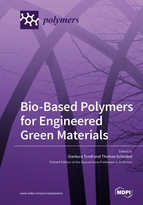Bio-Based Polymers for Engineered Green Materials
A special issue of Polymers (ISSN 2073-4360). This special issue belongs to the section "Biomacromolecules, Biobased and Biodegradable Polymers".
Deadline for manuscript submissions: closed (30 April 2019) | Viewed by 165621
Special Issue Editors
Interests: bio-materials; green chemistry; natural polymers; wood treatments; timber modification; bio-resources; insulation materials; preserving agent; fire resistance
Interests: wood extractives; biomass valorization; surface engineering; vibrational spectroscopy; bio-based composites; mechanical and thermal characterization
Special Issue Information
Dear Colleagues,
If the 20th century was dominated by synthetic polymers, the 21st seems to be when scientists have to provide greener-sustainable products maintaining the features which consumers are used to. In many field of technology, indeed, environmentally-friendly solutions are sought. The objective of the present Special Issue is to encourage the presentation of the most recent breakthroughs in engineered natural materials, especially when new solutions can significantly contribute to replacing synthetic plastics.
In this frame, the present Special Issue of Polymers will provide knowledge from the modification of bio-resources (e.g., wood) up to ecological solutions in the field of material science, with a special focus on the enhancement of properties of easily-available bio-resources, synthesis of natural-based materials, exploitation of bio-refinery streams and also comparative life cycle assessment studies.
We are looking forward to receiving your work.
Prof. Dr. Gianluca Tondi
Prof. Dr. Thomas Schnabel
Guest Editors
Manuscript Submission Information
Manuscripts should be submitted online at www.mdpi.com by registering and logging in to this website. Once you are registered, click here to go to the submission form. Manuscripts can be submitted until the deadline. All submissions that pass pre-check are peer-reviewed. Accepted papers will be published continuously in the journal (as soon as accepted) and will be listed together on the special issue website. Research articles, review articles as well as short communications are invited. For planned papers, a title and short abstract (about 100 words) can be sent to the Editorial Office for announcement on this website.
Submitted manuscripts should not have been published previously, nor be under consideration for publication elsewhere (except conference proceedings papers). All manuscripts are thoroughly refereed through a single-blind peer-review process. A guide for authors and other relevant information for submission of manuscripts is available on the Instructions for Authors page. Polymers is an international peer-reviewed open access semimonthly journal published by MDPI.
Please visit the Instructions for Authors page before submitting a manuscript. The Article Processing Charge (APC) for publication in this open access journal is 2700 CHF (Swiss Francs). Submitted papers should be well formatted and use good English. Authors may use MDPI's English editing service prior to publication or during author revisions.
Keywords
- Bio-materials
- Green solutions
- Bio-refinery
- Natural products
- Sustainable
- Bio-resources
- Engineered composites
- Environmentally friendly
- Life cycle enhancement








